Toshiba X305-Q725: Quad-Core Gaming Notebook
by Jarred Walton on March 11, 2009 1:00 AM EST- Posted in
- Laptops
General Application Performance
Wrapping things up with our performance testing, we have results from the Futuremark PCMark testing suites as well as some of our own application benchmarking. When it comes to running your office, multimedia, and Internet tasks, most modern laptops are more than fast enough. What follows are a few of the more strenuous application benchmarks - 3D rendering and video encoding - that put more of an emphasis on high CPU speeds. If you don't do that sort of thing on your computer, you will probably find that just about any Core 2 Duo processor is more than fast enough.
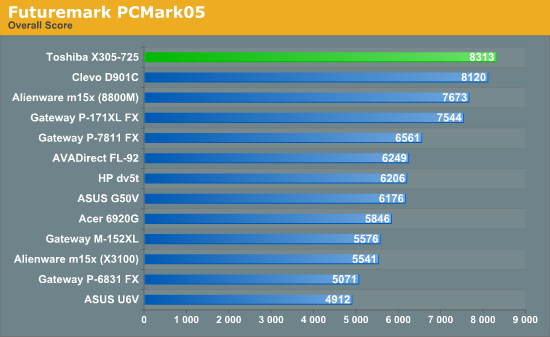
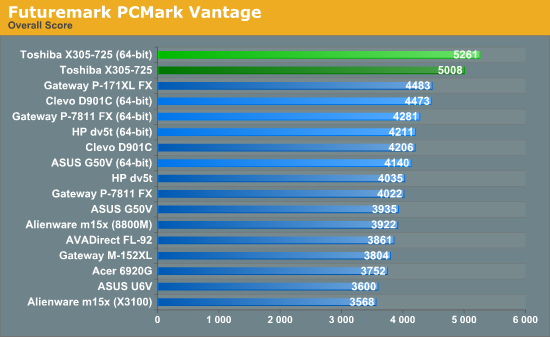
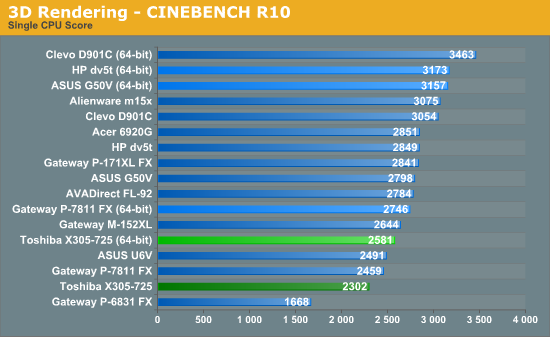

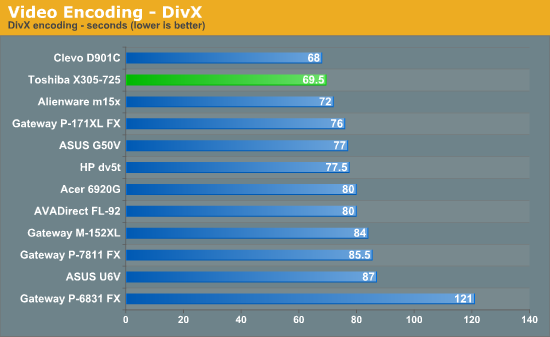
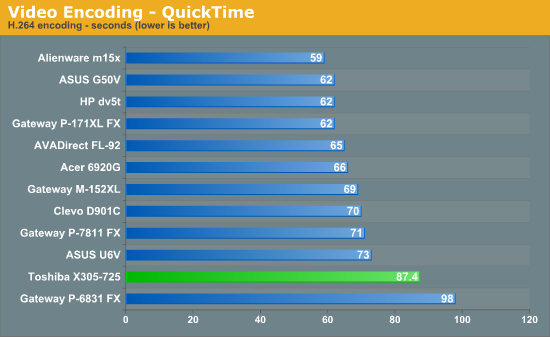
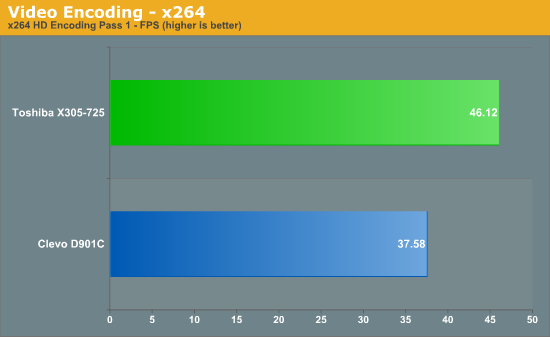
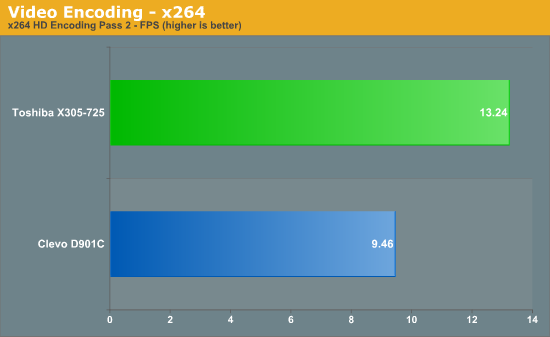
The quad-core CPU in the X305-Q725 does show its muscle in several of these tests, and the SSD helps elsewhere. PCMark definitely benefits the most from the SSD, with several of the tests stressing the ability to stream large amounts of data. Other tests like QuickTime were actually slower with the SSD, because of delays in writing the data. QuickTime also shows a situation that still occurs even with complex tasks on occasion: the lower clocked quad-core CPU ends up being slower than the dual-core CPUs because QuickTime won't utilize more than two CPU cores. DivX also fails to fully utilize the quad-core chip, with the total performance improvement over the E6850 at just 2.2%.
On the other hand, x264 benefits substantially, especially when you factor in clock speeds. Four cores at 2.0GHz theoretically provide up to 8GHz of processing potential, and the two cores of the E6850 at 3.0GHz provide 6GHz of potential, making the maximum theoretical improvement (all other things being equal) just 33%. The E6850 is an older architecture (Conroe instead of Penryn) but the E6850 also has more L2 cache per core; the fact that the Q9000 ends up being 40% faster on the second pass shows that there are scaling benefits from the newer architecture.
3D rendering is often able to scale almost perfectly up through four to six threads, so CINEBENCH R10 multi-core shows a nearly perfect increase of 32%. It's interesting that the single-threaded CINEBENCH score only shows a 33% advantage for the E6850, so again architectural changes in the Penryn core benefit the Q9000.
Overall, the X305-Q725 with the Q9000 looks like a good choice for highly threaded workloads, and the SSD can help in a few instances as well. However, there are competing laptops that offer similar performance for less money, or more performance for a similar cost, which makes the X305-Q725 more difficult to recommend.










32 Comments
View All Comments
Beno - Thursday, March 19, 2009 - link
"there are users that want this sort of system, and this review is targeted at that audience. Everything clear? Good, let's continue."these users need professional help!
szcsongor - Thursday, September 3, 2009 - link
Why? It's that hard to imagine that there are people (as me) who are travelling a lot (and working in different countries) AND who want a system, what is good for work and playing with the latest games? Travelling with a desktop PC is rather difficult...The truth is that I bought this rig in a refurbished (but perfect) condition for 1800USD, and for this price I think it wan't a bad deal. I wouldn't have paid 2000+USD for it either...
InternetGeek - Sunday, March 15, 2009 - link
I for one find the Qosmio's shape horrible, but the computer is a decent one. That Clevo smokes it on most benchmarks though, and does look nice as well. Where would you buy one online?JarredWalton - Sunday, March 15, 2009 - link
AVA Direct, Sager, and WidowPC all come to mind immediately. Eurocom is another option. The last I looked, I think Sager was actually the cheapest place for a fully equipped Clevo D901C system, but that can change at any time. Also, as I mentioned in a blog post, Clevo is coming out with the D900F that will use Core i7 desktop CPUs, so if you want more performance that's an option come ~April.Globemaster - Friday, March 13, 2009 - link
I'm away from home for up to 220 days per year, so without my Sager (Clevo 901C) I wouldn't be able to play the games I want, ever. My limited time at home needs to be spent keeping up the house/yard and with the family. I only get to game on the road, hence the utility of these types of notebooks - it's obviously a niche, but it seems like almost everything is these days.vj8usa - Thursday, March 12, 2009 - link
How come the specs of the laptops being compared against aren't all listed? It'd be nice to know what kind of hardware you're pitting this laptop against. It'd also be nice to perhaps put the CPU/GPU of each laptop next to its name in the charts.JarredWalton - Thursday, March 12, 2009 - link
If you visit the http://www.anandtech.com/mobile/">Mobile section of our site, you'll be able to find all the specs of recently tested laptops. Most of them are in the http://www.anandtech.com/mobile/showdoc.aspx?i=339...">gaming laptop roundup, and then there's a http://www.anandtech.com/mobile/showdoc.aspx?i=341...">couple more http://www.anandtech.com/mobile/showdoc.aspx?i=343...">laptop roundups. The http://www.anandtech.com/mobile/showdoc.aspx?i=337...">Gateway P-7811 was covered in a separate article. I suppose I could try to include specs, but the problem is with this many laptops included in results the specs page would get very long. I sort of assume people that follow the mobile articles have read the previous reviews and know what to expect, but that's obviously not the case all the time.7Enigma - Thursday, March 12, 2009 - link
Nice article, but I'd like to request that you put a "higher is better" or "lower is better", or whatever determines better for each of color graphs. Only the last one says "lower is better" and I'm completely naive to these tests.JarredWalton - Thursday, March 12, 2009 - link
All of the graphs are sorted so that the better scores are at the top of the charts. As for what the terms mean, I discuss that more in depth in an article I http://www.anandtech.com/displays/showdoc.aspx?i=2...">wrote a while back. In terms of what they should be, normally I'm fine with a maximum brightness of 200 nits, and a contrast ratio of 500:1 or better.Color accuracy and gamut are nice to have, but if you don't do image editing or color matching it often doesn't matter. If that's the case, good black levels might be more important than raw color accuracy. Watch a movie on a display with a poor black level, and even if the colors were accurate you'd likely be somewhat annoyed by the missing blacks.
Hope that helps some.
7Enigma - Thursday, March 12, 2009 - link
That makes it much easier. Maybe just a single line (if you don't want to put Lower/Higher is better) at the beginning of the section saying they are ranked from best to worst in each of the graphs? For instance, I have a pretty good understanding of calibration from performing maintainence on my RPTV, and so things like contrast, black level, color bleed into white, etc. I get. So I get that contrast ratio should be high, but didn't necessarily think the black level number should be low (makes sense now, but not when I was first viewing the charts).Anyways very nice review. I especially liked that you qualified the review in the first paragraph (and reiterated throughout) stating whom this laptop is targeted at which should (hopefully) limit the regular criticisms in the comments section against this niche market. I personally don't have a use for it, but enjoy reading about the new mobile pseudo-desktops, and certainly understand their value for several different professions.
Now go and pressure Anand for the SSD roundup! :) Please...